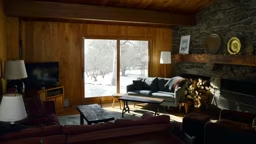Once beetles have chosen a winter site, scientists believe that they then use chemical cues from beetle feces or pheromones (chemical attractants) emitted by beetles that died the previous winter, to hone in on particular crevices in which to overwinter year after year. Many homeowners complain of annual invasions in which thousands of lady beetles (some have even reported 15,000 to 20,000) swarm their house, crawling in every window and crevice they can find. Although most ladybugs remain dormant in home siding and window casements all winter, some manage to find their way into the warmer interior of the house and become a major nuisance.
When disturbed, the ladybug secretes a yellow, noxious-smelling substance that is actually their blood. This process, called reflex bleeding, can leave stains on your carpet, curtains and walls and gum up your windows and window sills.
Eviction notice. How do you get rid of these unwanted guests? If you don’t want foul-smelling, yellow blood all over your cabin, your best bet is to sneak up on them with the vacuum cleaner.
You can also trap them with commercially available ladybug traps that use either a blacklight or a special-wavelength UV fluorescent light. These traps use a pheromone lure to attract indoor ladybugs, which then fall into a funnel and are trapped in a container.
Scientists have also looked at biological control of ladybugs and have identified a native tachnid fly as a potential predator capable of keeping the population in balance. Tachnid flies, which resemble house flies, are also beneficial insects in the garden and prey on such pests as cutworms, tent caterpillars and gypsy moth larvae.
So numerous are homeowner complaints that researchers at The Chemicals Affecting Insect Behavior Laboratory in Beltsville, Md., have been working to come up with harmless substances that effectively repel the beetles. Preliminary results suggest that camphor and menthol irritate the beetle’s sensitive chemosensory system.
The lady beetle has long been considered a symbol – a symbol of good luck, an omen of the coming harvest, a predictor of the impending birth of a son, or a means for forecasting the weather. American pioneers believed it was good luck when a lady beetle hibernated in their log home.
Today, we love to have them in our gardens, but “Ladybird, ladybird, fly away home” has an entirely new meaning to those of us who live in light-colored cottages!
Nancy Cain spends her winters in Vermont with thousands of ladybug friends.
When disturbed, the ladybug secretes a yellow, noxious-smelling substance that is actually their blood. This process, called reflex bleeding, can leave stains on your carpet, curtains and walls and gum up your windows and window sills.
Eviction notice. How do you get rid of these unwanted guests? If you don’t want foul-smelling, yellow blood all over your cabin, your best bet is to sneak up on them with the vacuum cleaner.
You can also trap them with commercially available ladybug traps that use either a blacklight or a special-wavelength UV fluorescent light. These traps use a pheromone lure to attract indoor ladybugs, which then fall into a funnel and are trapped in a container.
Scientists have also looked at biological control of ladybugs and have identified a native tachnid fly as a potential predator capable of keeping the population in balance. Tachnid flies, which resemble house flies, are also beneficial insects in the garden and prey on such pests as cutworms, tent caterpillars and gypsy moth larvae.
So numerous are homeowner complaints that researchers at The Chemicals Affecting Insect Behavior Laboratory in Beltsville, Md., have been working to come up with harmless substances that effectively repel the beetles. Preliminary results suggest that camphor and menthol irritate the beetle’s sensitive chemosensory system.
The lady beetle has long been considered a symbol – a symbol of good luck, an omen of the coming harvest, a predictor of the impending birth of a son, or a means for forecasting the weather. American pioneers believed it was good luck when a lady beetle hibernated in their log home.
Today, we love to have them in our gardens, but “Ladybird, ladybird, fly away home” has an entirely new meaning to those of us who live in light-colored cottages!
Nancy Cain spends her winters in Vermont with thousands of ladybug friends.
The ladybug is a study in contrasts. It really isn’t a bug. It’s a beetle, but it’s a beetle that everyone loves. Its cheerfully bright coloration and comically mechanical way of moving inspires interest and awe.
But, despite its dainty name, “ladybug,” “ladybird,” or “lady beetle,” its carnivorous appetite is far from ladylike. An important source of biological control for gardeners, lady beetles have been known to eat up to 100 aphids in a single day (aphids being small ruinous insects that suck the juices out of plants).
It’s a love/hate thing. Actually, we all used to like ladybugs until recent years when swarms of ladybugs – Asian lady beetles to be precise – started invading our cabins in the fall and wintering over.
Today, no place in my cottage is off limits: They treat my casement windows like Sunbelt condos, congregate in dark orange masses way up in the cathedral ceiling and occasionally motor across the snout of my sleeping golden retriever (and he doesn’t have aphids!).
How did it happen that ladybugs went from garden assets to household pests? Some believe that the Asian lady beetle (Harmonia axyridis), accidentally arrived in major U.S. ports by ship.
Others point to federal attempts to introduce the Asian lady beetle to the U.S. beginning in 1916 – to assist native ladybug species in controlling tree-feeding aphids and scale insects. The ladybug population got a big boost during the late 1970s through the early 1980s when systematic releases of tens of thousands of Asian lady beetles across the U.S. were attempted. By the early 1990s, the species finally became established.
Suddenly in the mid- to late 1990s homeowners began noticing swarms of ladybugs that would arrive in the fall, cluster on the sunny sides of their homes and litter their decks with a crunchy layer of beetles.
The gathering. Lady beetles are aggregating insects that come together two times a year: in the spring when they emerge for reproduction, and in the fall when seeking a winter home. Unfortunately, lady beetles tend to have a particular affinity for highly reflective colors like white or light-colored clapboard cottages. This attraction, it is thought, may be an innate behavior originating in their native Japan where they overwinter in white limestone cliffs.
But, despite its dainty name, “ladybug,” “ladybird,” or “lady beetle,” its carnivorous appetite is far from ladylike. An important source of biological control for gardeners, lady beetles have been known to eat up to 100 aphids in a single day (aphids being small ruinous insects that suck the juices out of plants).
It’s a love/hate thing. Actually, we all used to like ladybugs until recent years when swarms of ladybugs – Asian lady beetles to be precise – started invading our cabins in the fall and wintering over.
Today, no place in my cottage is off limits: They treat my casement windows like Sunbelt condos, congregate in dark orange masses way up in the cathedral ceiling and occasionally motor across the snout of my sleeping golden retriever (and he doesn’t have aphids!).
How did it happen that ladybugs went from garden assets to household pests? Some believe that the Asian lady beetle (Harmonia axyridis), accidentally arrived in major U.S. ports by ship.
Others point to federal attempts to introduce the Asian lady beetle to the U.S. beginning in 1916 – to assist native ladybug species in controlling tree-feeding aphids and scale insects. The ladybug population got a big boost during the late 1970s through the early 1980s when systematic releases of tens of thousands of Asian lady beetles across the U.S. were attempted. By the early 1990s, the species finally became established.
Suddenly in the mid- to late 1990s homeowners began noticing swarms of ladybugs that would arrive in the fall, cluster on the sunny sides of their homes and litter their decks with a crunchy layer of beetles.
The gathering. Lady beetles are aggregating insects that come together two times a year: in the spring when they emerge for reproduction, and in the fall when seeking a winter home. Unfortunately, lady beetles tend to have a particular affinity for highly reflective colors like white or light-colored clapboard cottages. This attraction, it is thought, may be an innate behavior originating in their native Japan where they overwinter in white limestone cliffs.
 dreamstime.com
dreamstime.com  dreamstime.com
dreamstime.com 









